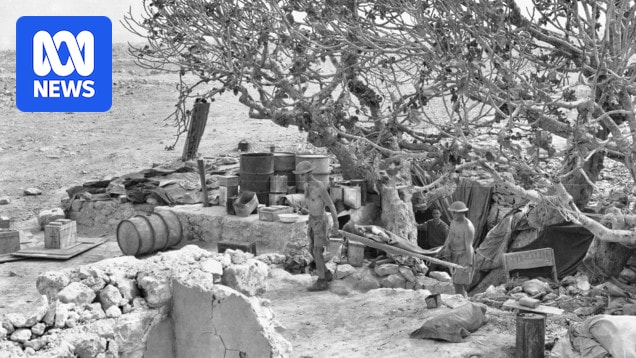Since a cutting from the famous Tobruk Fig Tree was brought back to Australia from Libya more than 80 years ago, dozens more have been taken and propagated around the country.
But until this week none had made their way to Port Lincoln despite “at least 100” of the Rats of Tobruk hailing from the Eyre Peninsula.
It was something 32-year-old history buff Tim Cook was determined to rectify when he first learnt about the World War II siege.
Caves beneath the original Tobruk Fig Tree served as a makeshift hospital during the siege. (Supplied)
“I had the idea for the first time when I was 13 or 14, so it has taken a long time,” he said.
“I had a fascination with war histories as a kid and I started looking a lot more into Australia’s involvement, reading a lot of books and watching a lot of documentaries, and I ended up zeroing in on the war in Africa.
“The one thing that stood out through all these documentaries and these books was this fig tree.”
An emotional planting
More than 18 years later, Mr Cook and his mum, Julie Cook, were given the honour of planting the sapling in front of the local descendants of the Rats of Tobruk this week.
Among them were Graeme, Paul, Jack and Noelene Bourke, whose father, Allan Bourke, was wounded during the siege and treated at “Fig Tree Hospital” — the makeshift dugout whose entrance was marked by the tree.
Allan recovered from his injuries and came home, but his brother Bernard Bourke was wounded and killed in battle in Egypt in 1942.
Graeme Bourke (second from right) with other Rats of Tobruk descendants and community members. (ABC Eyre Peninsula: Tim McGlone)
Back in Australia, Allan started a family on the block of land he was awarded at Wanilla, on the southern part of the Eyre Peninsula.
He died in 1989 but his legacy as a Rat was destined to live on.
“I got quite emotional about it during the planting,” Graeme said.
“Just for the history of that tree at Tobruk and here it is, replicated to a point, in Port Lincoln.
“[Fig Tree Hospital] was an area where the soldiers could feel safe.”
The sapling is a descendant of the original tree, which sat at the entrance to the field hospital. (ABC Eyre Peninsula: Tim McGlone)
Rats of the Eyre Peninsula
According to local historian Lee Clayton, many of the 14,500 Australia soldiers at Tobruk came from South Australia.
“At least 100 were from the Eyre Peninsula, but it is likely to be much more, as many went to Adelaide and enlisted there, so it is difficult to know exactly where everyone was from,” he said.
The campaign waged by Australian soldiers in the harsh North African desert for 242 days in 1941 was a critical battle during the World War II.
Mr Clayton said the Rats — those in the 9th Division – proved “very annoying to the Germans”, who had not been defeated until that point.
Lee Clayton says thousands of South Australians were involved in the Siege of Tobruk. (ABC Eyre Peninsula: Tim McGlone)
“Tobruk was a battle that many Eyre Peninsula soldiers were involved in,” Mr Cook said.
“The tree was a symbol of defiance and, I suppose, a symbol of hope for those that were involved in the siege.
“They knew they would be safe there.”
Tim Cook conceived of the idea of the tree when he was a 14-year-old army cadet. (ABC Eyre Peninsula: Tim McGlone)
Long process to get sapling
Mr Cook worked with the Melbourne-based Rats of Tobruk Association to coordinate the sourcing of a sapling from the original Tobruk fig.
He explained that the ailing health and passing of members had made the task challenging and delayed its completion.
Australia’s last surviving Rat of Tobruk, Tom Pritchard, had died last year at the age of 102.
Australian and other Allied soldiers repelled Italian and German attacks during fierce combat in Tobruk. (Supplied)
“It’s certainly been a process [to get a sapling], to the fault of no-one,” Mr Cook said.
“I’m glad Mum and I have been able to see it through … it’s a really great day.”
City of Port Lincoln Mayor Diana Mislov said the fig was “more than a tree”.
“It’s a powerful symbol of remembrance and resilience,” she said.
“We are privileged to have this.”
Australian troops fighting hard at Tobruk in 1941. (Supplied: Australian War Memorial)
Graeme Bourke said the connection formed between returned soldiers and their families had stood the test of time.
“There were about 38 families who came to Wanilla in the late 40s, early 50s … the families of soldiers who had served, and airmen,” he said.
“Consequently, I was brought up in that community out at Wanilla.
Everyone knew each other — we could almost be termed as one big family from out there.”
